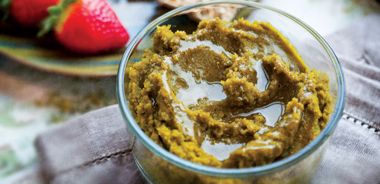Honey Pistachio Butter

One taste of this rich nut butter and you may never go back to the store-bought variety. If you want your spread to be a vibrant green, you’ll need to remove the pistachio skins before grinding. And you can splurge for shelled nuts if you want to avoid tender fingertips. Spread on toast, whole grain crackers, crepes, or even fruit. By the spoonful is good too!
2 cups (500 mL) unsalted shelled pistachios
1/3 cup (80 mL) lukewarm water
2 Tbsp (30 mL) light honey, such as clover or alfalfa
1 tsp (5 mL) natural vanilla extract
Place pistachios in pot of boiling water and blanch for 3 minutes. Drain and rinse under cold water. Working in batches, place pistachios on a clean kitchen towel, fold, and rub off the skins. In skillet over medium heat, toast skinned pistachios until fragrant, about 4 minutes. Let cool.
Place cooled nuts, water, honey, vanilla extract, and a pinch of salt in food processor and grind until smooth and buttery. If needed, add additional water, only 1 Tbsp (5 mL) at a time, to help with blending.
Serves 8.
Each serving contains: 187 calories; 6 g protein; 14 g total fat (2 g sat. fat, 0 g trans fat); 13 g carbohydrates; 3 g fibre; 59 mg sodium
from "Hey, Honey!", alive #355, May 2012





